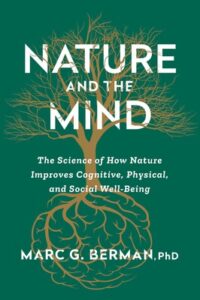I’ve been a professor at the University of Chicago for over ten years, and when something is troubling me, I try to find time to take some walks in nature. But when I think about nature’s effect on mental health, I’m often taken back to my last year as a graduate student.
Article continues after advertisement
The Ann Arbor sun beamed down, but I hung my head. It was mid-June 2010. The rush of media attention for my “Walk in the Park” study had started to settle down, and we were thinking about our next studies. I was getting ready to defend my dissertation. Professionally, I was on my way, but personally, not so much. As I crossed the parking lot and walked into Barton Park, I scowled at a couple holding hands on the bridge over the Huron River. I turned away from other couples sharing rowboats and tandem kayaks. I kicked a pebble, and then, to avoid further company, took a detour through a tall-grass field, circling back to the main path only at the last possible moment to get to my ancient oak tree.
I stood in front of its mottle-barked majesty, and I started talking.
It had been two years since that first study of the cognitive benefits of interacting with nature had been published. Assuming everything went well with my dissertation, I’d start applying for jobs in September, but now I was playing hooky from an important conference.
I stood far enough away to take in my oak’s impressive stature, but close enough, I hoped, so that she could hear me.
My mentors, Steve and Rachel Kaplan, the academic couple who originated attention restoration theory, had organized a reunion on campus of current and former students and collaborators. The occasion was also timed to coincide with the Kaplans’ fiftieth wedding anniversary.
But the day before, in a painful irony, my longtime girlfriend Heather broke up with me. I felt distraught. I couldn’t concentrate through the morning sessions at the conference. I tried to power through, but at every pause, I felt as if I was on the verge of crying. No matter what the presenters said, I just couldn’t focus. All my thoughts went back to the breakup. We had dated for almost two years. I had thoughts that we might get married.
Finally, I approached Steve and told him what had happened.
“Just leave,” he told me. “You know what to do, Marc.”
I realized I did know what to do. Instead of hiding inside myself and spiraling into rumination, I needed to go someplace that could restore me.
I headed to Barton Park to walk in nature, but not even Steve knew that over the past two years since we’d published that first study, I’d taken to treating my favorite oak tree like a silent, sturdy therapist. I stood far enough away to take in my oak’s impressive stature, but close enough, I hoped, so that she could hear me.
“It’s over with Heather,” I confessed. “Now I have to move out and find a new place to live. I’m single, broke, and nearly thirty. My friends are buying houses and getting married and having kids.” I teared up. “I feel like a loser,” I said. “What am I doing wrong?”
The wind blew. Leaves rustled. Squirrels chittered. Nearby, in the surrounding meadows, fresh wildflowers bloomed while centuries-old roots burrowed deeper. I sighed, still feeling the weight of my sadness. But after whining a bit about all my failures, I felt lighter, too. I trudged on until I reached a large wooden bridge that cut across a wide portion of the Huron River. From here, trees and water stretched out into a seeming infinity of greens and blues.
As I inhaled, I noticed something else beyond these new glimmers of clarity: I felt better physically.
I still felt miserable, but little by little, that feeling began to lessen. Sights, sounds, smells, and textures of the park filtered in: A hawk circled overhead, mud caked my sneakers, a family riding bikes together passed, and I felt the wooden rails of the bridge against my palms. My mind wandered. Images from my life with Heather flashed, but I noticed that the anger and hurt started to settle into a more neutral feeling. Finally, I gained sufficient clarity to make a plan. First, I’d drive home for the weekend, crash with my parents, eat some home cooking, and rest. Then, I’d return to campus Monday morning, apologize again to Steve, and join the going-away party for the lab manager of my other mentor, John Jonides.
Trading the incredible networking opportunity of the Kaplans’ on-campus conference to pour my heart out to a tree was both a desperate measure and, I hoped, the surest way to reclaim my focus, energy, and good humor.
As I inhaled, I noticed something else beyond these new glimmers of clarity: I felt better physically. I hadn’t studied that effect yet. I exhaled. My breath had steadied. My personal life was a burning crater. But science—and nature—might save me yet.
As I headed back to my car, I thought about all of the cognitive and emotional benefits of nature we’d found so far. There was still more work to do. By taking this walk, I was taking my own medicine.
But I still couldn’t have imagined the results.
*
Human beings have spent millennia building homes, fences, and societies to separate ourselves from nature (and for good reasons). We need shelter to protect us from rain and snow, barriers to keep out predators that would hurt us or our livestock, and commerce routes to streamline the way we get our basic necessities and more. But do we feel any safer on a day-today basis? Another fact: The US self-help industry takes in over thirteen billion dollars a year—money we spend largely trying to make ourselves happier—but rates of depression have reached new heights in recent years. According to a 2023 Gallup poll, 29 percent of US adults report having been diagnosed with depression at some point in their lives, nearly ten percentage points higher than in 2015. Much of this jump seems to coincide with the COVID-19 pandemic, but there had been a steady rise in depression even before the pandemic. Even for those of us not experiencing clinically diagnosable levels of anxiety or depression, how many of us can say we feel as safe and happy as we’d like?
In Norway, a country consistently ranked among the happiest in the world, the concept of friluftsliv—or “free nature life”—is part of the national identity.
I know, I know. It’s pretty cliche to say that Scandinavians and Nordic countries do everything better, but stay with me.
When people everywhere welcome nature into their lives instead of cutting themselves off from it, they benefit.
The playwright Henrik Ibsen coined the term friluftsliv in the nineteenth century, but the concept is much older and encompasses outdoor activities from hiking in the forest to paddling across a lake to simply sitting in a wooded park and listening to the birds. According to Bente Lier, the secretary-general representing hundreds of outdoor clubs in Norway, “It is our goal to include everyone in friluftsliv, including people with disabilities and psychological challenges and those on low incomes.” More than 75 percent of Norwegians spend time in nature on a weekly basis—and 25 percent do so on most days.
In Finland, Grandma Ruth’s ancestral land, the people’s relationship to nature is similar. In The Finnish Way, Canadian author Katja Pantzar recounts a young adulthood spent battling depression and anxiety in Toronto and Vancouver. She took prescription medication, but never thought much about the fact that her lifestyle—celebrity-obsessed, work-centered, junk food–fueled, and nature-deprived—might be contributing. But when she took a job in her ancestral country of Finland and immersed herself in a lifestyle that included daily doses of nature, things slowly but noticeably started to turn around. She biked for exercise, got in the habit of taking cold plunges, used “forest therapy” and steamy outdoor saunas, and consciously centered a kind of bravery and endurance the Finns call sisu. Sisu can be roughly translated as grit, determination, strength of will, perseverance, and the ability to act rationally and with self-regulation in the face of adversity. Pantzar admits that when she first encountered this sisu quality, she mistook it “for stubbornness, eccentricity, or a thriftiness that seems foreign and totally unnecessary to me.”
I thought of my grandma Ruth, with her Finnish heritage. Some of my cousins thought she was mean, and certainly stubborn. The image of her cutting a snake in half with her shovel doesn’t conjure up a touchy-feely woman. But she had sisu in spades. Her salt-of-the-earth attitude, along with her deep connection to her land, cradled her resilience.
I wondered: Were friluftsliv and sisu the Nordic secret to happiness?
Scandinavians and people from Nordic countries do seem to be healthier and happier than much of the rest of us. Some say it’s easier to have better social, environmental, and health systems when you have smaller, more isolated and homogeneous countries, buffered from the problems of much of the rest of the world. But rather than dismissing frilusfsliv and sisu for these reasons, why not try to figure out how it can work for all of us?
That’s what I was thinking about when I returned from spending the weekend at my parents’ house in suburban Detroit, surrounded by my old high school tennis trophies and posters of Magic Johnson, the great Michigan football player Charles Woodson, and a Lamborghini Diablo. I returned to campus for the Jonides lab dinner. As I grabbed a beer and a full plate of barbecue, I spotted Martin and Susanne, a long-standing but still clearly enamored Swiss postdoc couple, trading an inside joke in Swiss German. They clinked glasses to say cheers, and then, right away, gave each other a kiss. Why can’t I have that? I thought.
I sat down at a table with empty chairs. Soon Katie Krpan, the postdoc in the lab who’d helped me conduct a depression study, sat down next to me. Katie was Canadian, from Toronto, but ethnically Croatian on her father’s side and Polish on her mother’s side. Tall, with caramel-brown eyes and long chestnut-brown hair—well, frankly, I found her supermodel-scale beauty intimidating.
But today, Katie looked sad. I must have still looked sad, too, because she asked how I was. “Down,” I admitted. “Heather and I just broke up.”
“Well,” said Katie, “my partner and I are splitting up as well.”
I felt bad for Katie, but I also felt a little surge of happiness. I wasn’t alone in my pain. I raised my beer. “We can be misery buddies,” I said.
Katie smiled, and we clinked glasses.
We were both sad and talked about how we should be taking more nature walks based on the results of our nature and depression study. We also discussed other scientific and nonscientific topics. We decided to hang out two days later. A few years later, Katie and I were married—with children.
And pretty soon, researchers around the world would begin to establish the antidepressant effects of nearby nature we had discussed—and not just for Scandinavians. When people everywhere welcome nature into their lives instead of cutting themselves off from it, they benefit.
__________________________________

From Nature and the Mind: The Science of How Nature Improves Cognitive, Physical, and Social Wellbeing by Marc G. Berman, PhD. Used with the permission of the publisher, S&S/Simon Element. Copyright © 2025 by Marc G. Berman.
Source link

